Creating a harmonious pet bird habitat within your house is instrumental for the health and emotional well-being of your feathered companion. Understanding the best place for a pet bird cage not only contributes to bird safety but also enhances bird comfort, encouraging a fulfilling life filled with vibrant social interaction.
Your pet bird’s enclosure should be spacious, providing them with the freedom to stretch their wings and engage in necessary activities, akin to their natural behaviors. Let’s embark on setting up the perfect space within your home that balances the requirements for safety, involvement, and tranquility for your pet bird.
Key Takeaways
- Identify a location that supports natural bird behaviors and allows enough space for flight.
- Place the cage in a spot that avoids high-traffic and reduces stress for better bird comfort.
- Ensure the cage is predator-proof and situated securely for optimal bird safety.
- Factor in lighting and temperature to create a beneficial pet bird habitat.
- Recognize the importance of social interaction and integrate your pet bird into family activities safely.
Understanding Your Pet Bird’s Needs for Space and Environment
As a dedicated bird owner, it’s imperative to grasp the intricacies of indoor bird cage setup to ensure your pet’s happiness and well-being. The habitat you create within your home must echo the bird’s natural environment, with a particular emphasis on the size of the enclosure and its positioning. These elements are critical not only for their comfort but also for their overall health and ability to express instinctual behaviors.
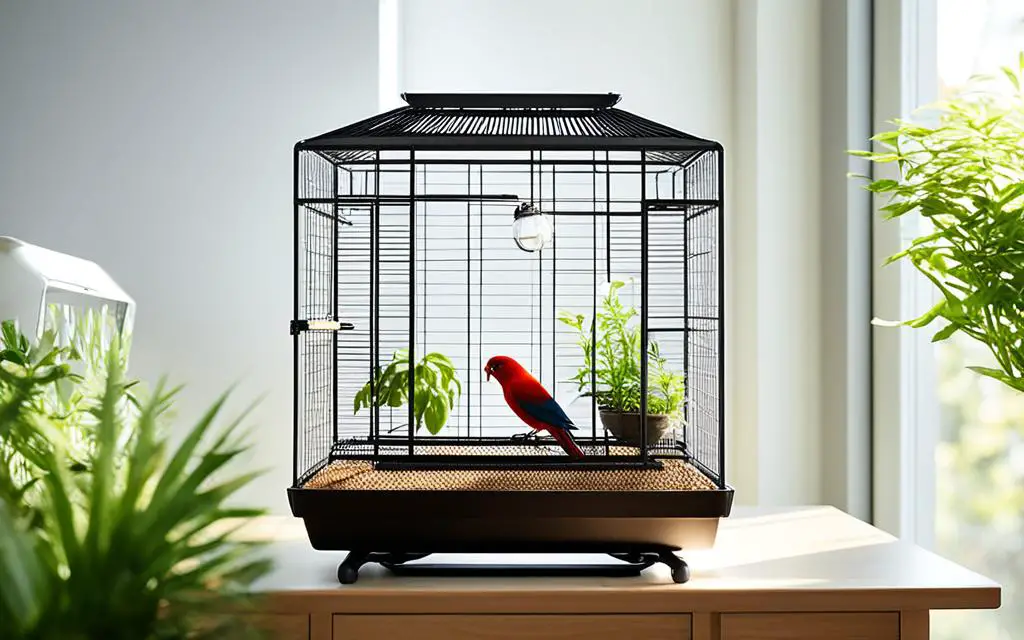
The Importance of Cage Size for Movement and Flight
The dimensions of your bird’s cage are more than a simple matter of convenience; they directly impact your bird’s ability to exhibit natural movements and behaviors. In your pursuit of the perfect bird cage placement, prioritize horizontal and vertical space that allows your feathered friend the freedom to spread their wings and engage in short flights, essential for both their physical exercise and mental stimulus.
Considering the Social Behavior of Birds for Cage Placement
Birds are inherently social creatures, flourishing in environments that cater to their communicative and interactive nature. When determining your bird’s cage placement, consider the location as a vantage point for your bird to observe and interact with their surroundings—be it with other birds or with the human members of their “flock.” Such strategic pet bird enclosure tips play a significant role in nurturing the social bonds that are pivotal for your bird’s emotional health.
Optimal Conditions for Physical Health and Stimulation
Striking the balance between accessibility and secure respite is key to a harmonious indoor bird cage setup. You must also bear in mind the need for protection against the elements and potential hazards, from ventilation that avoids drafts to a location safe from the reach of predators. Providing a stimulating environment with movable perches and toys, which also safeguards against undue stressors, will forge a space that promotes a thriving, content, and zestful avian life.
| Component | Description | Benefits |
|---|---|---|
| Cage Size | Large enough to allow free movement and flight | Encourages exercise and natural behavior |
| Social Considerations | Positioning that promotes interaction | Reduces isolation and fosters social health |
| Environmental Enrichment | Inclusion of movable perches and toys | Stimulates mind and body, preventing boredom |
| Positioning | Safe from elements and predators, adequate ventilation | Ensures physical health and comfort |
Criteria for Selecting the Best Place for Pet Bird Cage
When it comes to setting up a pet bird habitat, the location of your bird’s cage is just as important as the cage itself. Choosing the right spot within your home can greatly influence your bird’s quality of life by ensuring bird comfort and providing a stable environment that encourages natural behaviors. Below, we will discuss how natural light and temperature control play a pivotal role in promoting a healthy and comfortable atmosphere for your pet bird.
Natural Light and Its Benefits for Birds
Natural light is an essential element in creating a suitable pet bird habitat. It not only helps to sustain your bird’s biological clock but also stimulates activity and promotes well-being. To reap the benefits of daylight, place the cage where it can receive moderate, indirect sunlight, which mimics the lighting of a natural environment and fosters vigorous daytime behavior. However, direct exposure must be avoided to prevent risks of overheating and stress, ensuring your bird remains comfortable throughout the day.
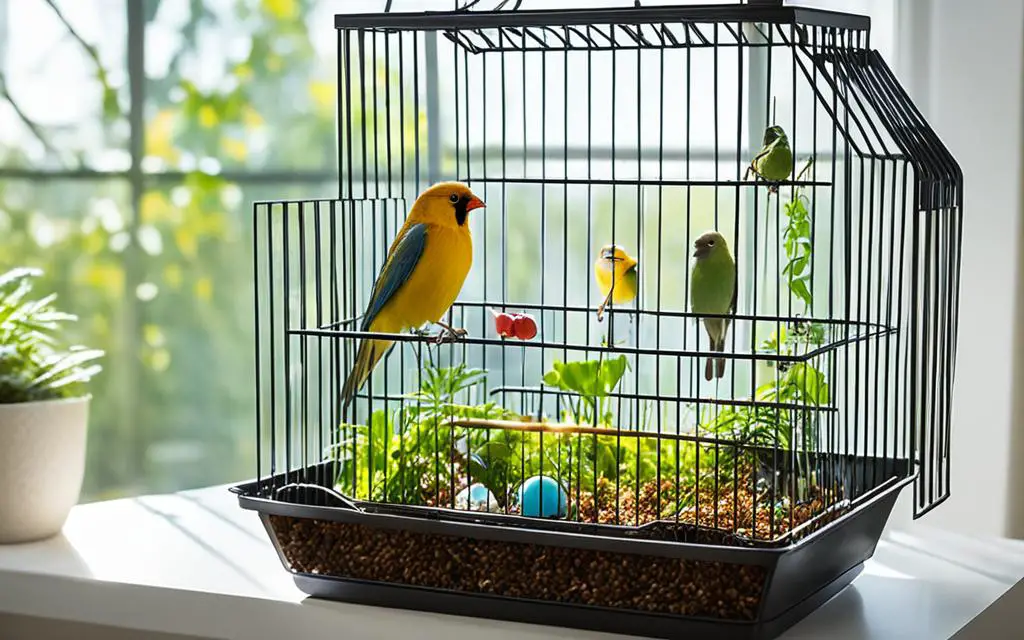
Temperature Control to Prevent Health Risks
Stable and appropriate temperature is another cornerstone for maintaining a salutary pet bird habitat. Birds are sensitive to temperature fluctuations, so it’s crucial that their environment is neither too hot nor too cold. Spot bird cage locations away from air vents, drafts, and direct heat sources. Consistently comfortable temperatures encourage relaxation and prevent health complications, contributing to the overall thermal comfort of your bird.
| Factor | Recommendation | Benefits |
|---|---|---|
| Natural Light | Filtered, indirect sunlight | Encourages natural behaviors and regulates biological rhythms |
| Temperature | Avoid extremes; stable ambient warmth | Prevents stress, ensures comfort, and supports health |
Selecting the proper bird cage location is more than a matter of aesthetics—it is a thoughtful decision that enhances your pet’s life. By prioritizing these criteria, you can ensure that your bird’s habitat offers security, pleasure, and alignment with their instinctual needs for temperature control and exposure to natural light.
How Indoor Bird Cage Setup Impacts Bird Safety and Comfort
Setting up your bird’s indoor cage requires careful consideration to ensure their bird safety and comfort. A conducive pet bird habitat minimizes stress and promotes healthy living, elevating the quality of life for your avian companion. Be mindful of the position within your home as it can greatly affect these key aspects of your bird’s environment.
Avoiding Drafts and Sudden Temperature Changes
Creating a stable environment for your pet means mindful bird cage location selection. Avoid areas where drafts or sudden temperature changes are prevalent, such as near doors, windows, or air conditioning vents. Drafts can be particularly distressing and potentially harmful to birds, leading to respiratory issues or undue stress. Instead, place your bird’s cage in a location with a consistent and moderate climate to support their well-being.
Avoiding Toxins: The Risks of Fumes from Kitchens and Non-Stick Cookware
Your bird’s respiratory system is delicate and highly sensitive to airborne contaminants. Toxic fumes, which can emanate from kitchens or when heated, non-stick cookware releases harmful gases, must be scrupulously avoided in the vicinity of your pet bird’s cage. This not only pertains to kitchen-related fumes but also to those released from cleaning products, paints, or scented candles. Ensure your bird cage location is distant from these potential sources of toxins to maintain a safe and healthful habitat for your feathered friend.
| Environmental Factor | Risks to Avoid | Safety Measures |
|---|---|---|
| Drafts and Temperature Fluctuations | Drafty areas, near HVAC systems | Stable location with consistent temperature |
| Toxins and Fumes | Kitchens, non-stick cookware, household chemicals | Cage placed in well-ventilated areas away from the kitchen |
In safeguarding your bird, it is imperative to set up their cage in a location that protects them from environmental hazards. A secure and healthful environment is marked by clean, fresh air and a stable temperature. As you prioritize your bird’s safety and comfort, remember that your diligence in pet bird habitat management is the cornerstone of your companion’s happiness and longevity.
Creating a Pet Bird Habitat for Mental Well-Being
For your pet bird to thrive, its environment must be attuned not only to its physical needs but also to its mental well-being. A thoughtfully designed pet bird habitat influences your bird’s quality of life, ensuring they remain active, engaged, and happy. Dive into the elements that make up a stimulating space and discover how the right cage placement can contribute to your bird’s overall psychological health.
Environmental Enrichment: The Role of Toys and Perches
The inclusion of various environmental enrichment tools is vital in creating an inviting and stimulating area for your bird. Ample pet bird enclosure tips revolve around the addition of movable perches that encourage exploration and physical activity. A variety of toys should be implemented to enhance mental stimulation, staving off boredom and promoting healthy play behaviors. Such enrichments mimic natural activities your bird would partake in the wild and are critical for their psychosocial development.
Toys and perches serve not merely as diversions but as essential components that support the need for your bird to engage in problem-solving and skill-honing activities. Rotating these enrichment items encourages interaction and provides an evolving landscape within the confines of the cage, fostering environmental complexity that birds naturally crave. From foraging toys that trigger instinctual behavior to perches that exercise their feet and encourage movement, every addition should have a purpose toward overall enrichment.
Social Interaction Necessities for Pet Bird Psychosocial Health
Birds are inherently social animals, and isolation can lead to negative psychological effects such as anxiety or behavior issues. A critical aspect of your pet bird’s health is regular social interaction, whether with other birds or with human family members. When contemplating cage placement, consider a spot that allows your bird to observe and participate in daily activities without becoming overwhelmed by excessive noise or traffic; a balance between engagement and tranquility is key.
Creating opportunities for your pet to interact, such as positioning the cage at eye level in a living space, allows them to feel like an integral part of the ‘flock’. It is essential that these interactions are positive and fear-free. By physically establishing your bird’s habitat within social proximity, while respecting their need for privacy and downtime, you encourage a behaviorally sound and content companion.
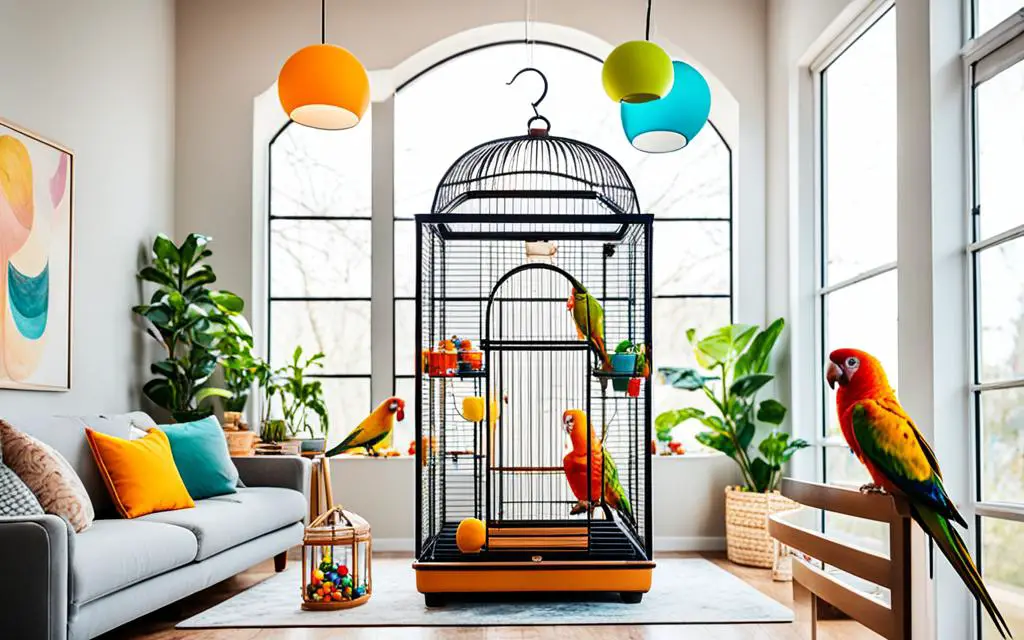
Where in Your House Should a Pet Bird Be Kept? Evaluating Traffic and Noise
Finding the ideal bird cage placement is crucial to your feathered friend’s comfort and well-being. It’s pivotal to consider both the noise level and traffic flow within your home to ensure your bird thrives. A location with excessive noise or heavy foot traffic can startle and stress birds, so aiming for a serene yet socially integrated spot is key. Let’s delve into how you can select a site that fosters social connectivity while maintaining peace.
Typically, living rooms are hubs of activity with fluctuating noise levels, which can be overwhelming for a pet bird. Conversely, bedrooms offer tranquility but may limit social interaction. Your goal is to achieve a happy medium—for instance, a quiet corner of a living room where your bird can witness household comings and goings without the constant hubbub. I keep my birds in my home office. This works best in that the birds get plenty of interaction.
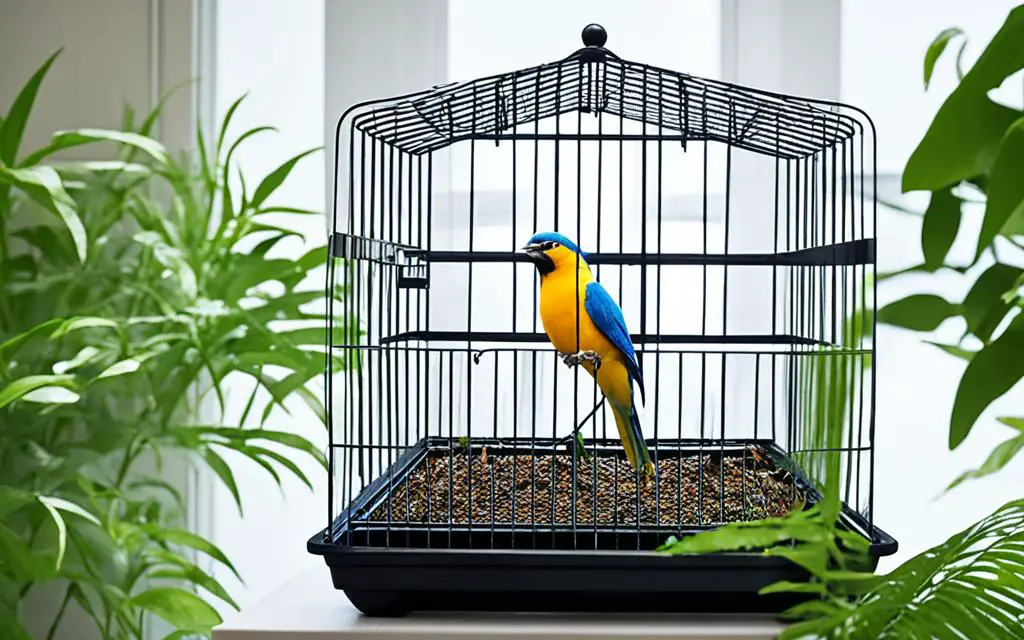
- Identify areas in your home with minimal but consistent movement, as birds appreciate predictable environments.
- Place cages away from kitchens and televisions to avoid startling sounds and disruptive vibrations.
- If possible, choose a room with doors to reduce unintended disturbances.
When creating a conducive habitat for your pet bird, think about how the position of the cage within a room can affect your bird’s daily experience. Positioning a cage against a wall can provide a sense of security, yet having one side open allows for beneficial engagement with family life.
| Room | Noise Level Consideration | Advantages | Disadvantages |
|---|---|---|---|
| Living Room | Medium to High | Social contact, part of family activities | Can be loud, frequent traffic |
| Bedroom | Low | Peaceful and quiet, undisturbed rest | Limited social interaction |
| Study/Office | Low to Medium | Consistent, controlled noise level | Space may be limited |
| Designated Bird Room | Customizable | Specially tailored environment, control over factors | May require additional space and resources |
Remember, by considering both traffic flow and noise level, you can find a place that ensures your pet bird is part of your home’s rhythm without compromising on their need for a peaceful haven. Strive to provide the best of both worlds, and you will nurture a content and healthy feathered companion.
Promoting Bird Comfort: Understanding Ventilation and Drafts
Creating an ideal pet bird habitat involves more than just a stylish cage—it’s about ensuring a healthy atmosphere for your feathered companions. One of the essential elements for maintaining bird comfort involves understanding the balance between ventilation and protection from drafts. The location of your bird’s cage within your home can significantly impact its exposure to varying air flows. Proper ventilation is not just about guaranteeing fresh air; it also serves as a frontline defense against the buildup of harmful toxins that could undermine your pet’s health.
While it’s important to allow a suitable amount of air to circulate within and around the bird’s living area, great care should be taken to position the cage in areas where sudden gusts of wind and sharp changes in temperature are minimal. This can be especially challenging in certain layouts of modern homes. It’s not only about bird cage placement; it’s about integrating your bird’s living space within your own to enhance shared environmental quality.
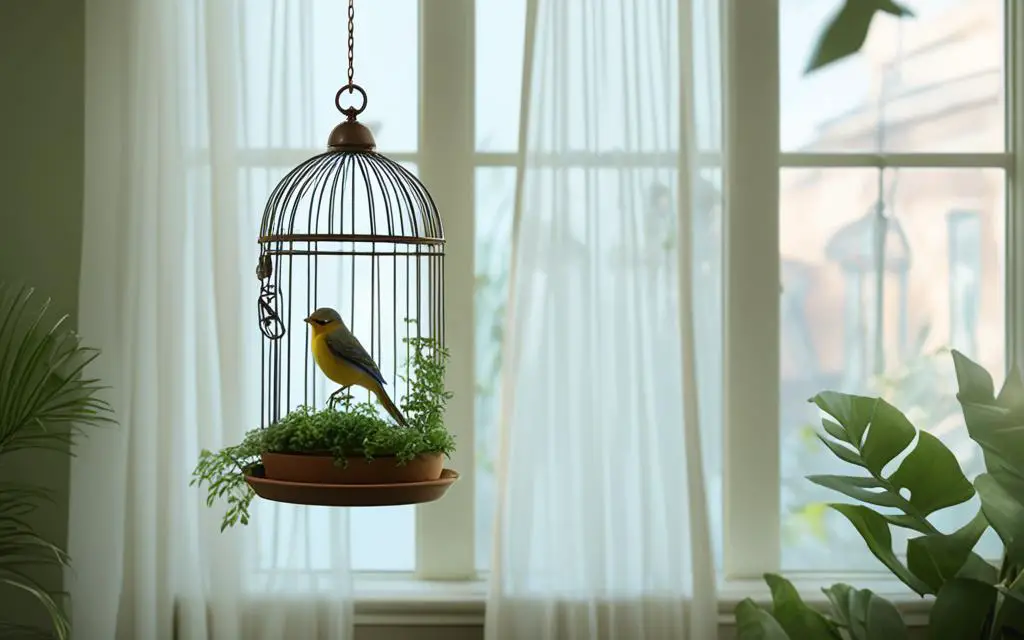
When you consider the placement of your bird’s cage, think about the proximity to windows, heating, ventilation, and air conditioning systems. Drafts are often not detected until after the cage is in place, so observe the airflow patterns in your home throughout the day before deciding on a permanent spot. By doing so, you not only avoid cold drafts but also protect your bird from direct exposure to sunlight which could cause overheating—another important aspect of bird safety.
| Consideration | Impact on Bird Comfort | Best Practices |
|---|---|---|
| Ventilation | Prevents toxin accumulation, maintains fresh air supply | Ensure cage is placed in an area with steady, clean air flow |
| Temperature Stability | Protects against stress and health risks associated with temperature fluctuations | Avoid placing near drafts, windows, or HVAC vents |
| Accessibility of Fresh Air | Essential for respiratory health and comfort | Half of the cage’s sides should allow air to pass freely without causing drafts |
| Protection from Direct Sunlight | Prevents overheating and discomfort | Locate cage in an area with indirect, filtered light |
Ultimately, thoughtful bird cage placement that prioritizes steady ventilation while shielding your pet from discomforting drafts will contribute significantly to your bird’s overall comfort. As you calibrate these environmental details, you’ll ensure that your bird’s habitat provides not just a living space, but a sanctuary for joyous and healthful living.
Protecting Your Pet Bird from Household Hazards
Ensuring bird safety in your home is not just a matter of providing a cage with a door. The reality is that household hazards pose a significant threat to your feathered companions. Risks such as cleaning chemicals, loud noises, and predatory pets can create stressful, even life-threatening situations for birds. It’s essential to be proactive about identifying potential dangers within your home and establishing measures to mitigate these threats for the health and happiness of your pet bird.
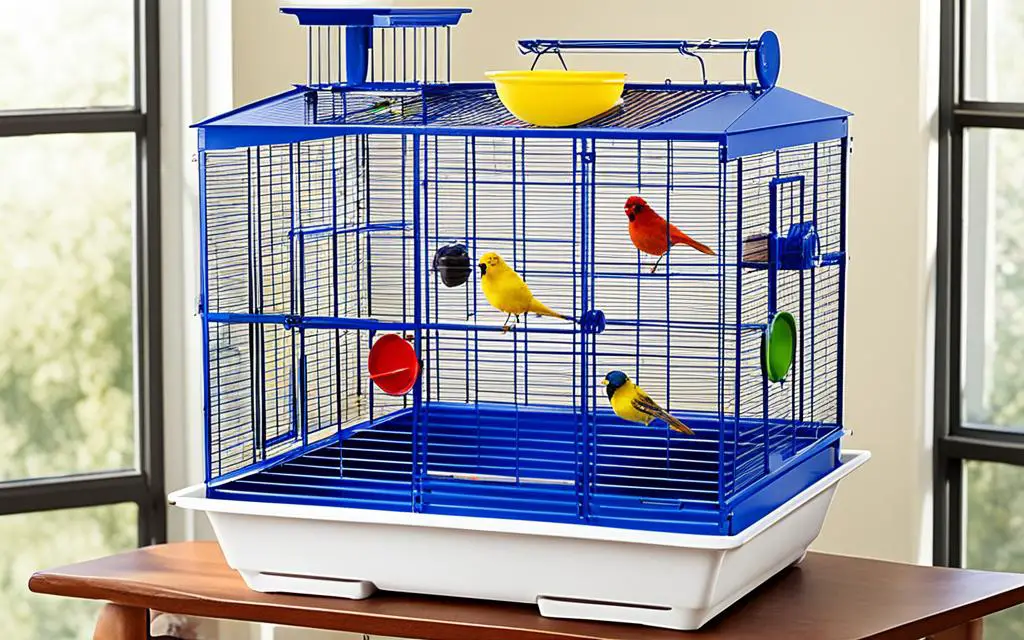
Common Household Dangers: Cleaning Chemicals, Loud Noises, and Predators
Among the common household hazards are the chemicals found in many cleaning products. These can release toxic fumes that are particularly harmful to birds due to their highly sensitive respiratory systems. Moreover, birds can be easily stressed by loud noises from household appliances, electronics, or high-traffic areas. This can cause lasting harm to their mental well-being. Predators, including other pets in the household, can likewise be a source of sustained stress or direct danger to birds if they are able to access the bird’s living space.
Setting Up Safe and Secure Enclosures: Avoiding Escape and Contamination Threats
A secure enclosure is your first line of defense in protecting your pet bird. A well-planned pet bird habitat will be escape-proof, limiting the risk of your feathered friend flying into harm’s way. The enclosure should also be positioned to keep feed and water containers clear from contamination—whether by in-cage perching position or external environmental factors. To help in setting up an optimal environment, here are some pet bird enclosure tips:
- Position cages away from kitchen areas to avoid exposure to toxic fumes from non-stick cookware or cleansing agents.
- Choose a quiet location for the cage to minimize stress from loud household noises.
- Ensure that all enclosure latches are secure to prevent escapes.
- Avoid placing the bird’s cage in direct line of sight with household pets like cats or dogs.
By attentively addressing these aspects, you are laying down the foundations for a safe and joyous habitation for your avian companion. When it comes to bird safety, prevention is key, and a bird-friendly household is one that considers their natural needs and behaviors in the layout and routine of the home.
Optimal Bird Cage Position for Aiding Natural Behaviors
Creating a space for your pet bird that fosters their inherent behaviors is crucial for their well-being. Selecting the optimal bird cage position is a direct reflection of your understanding and commitment to replicating the enriched environment they would encounter in nature. This includes access to sunbathing, shelter, and opportunities to forage—activities that contribute to their physical health and psychological satisfaction.
Ensuring Access to Sunbathing and Shelter Areas
Just like in their natural habitats, birds in captivity relish the ability to bask in sunlight or retreat to the comfort of the shade. When contemplating the placement of your bird’s cage, consider an area where sunlight filters through gently—preferably through a window with a sheer curtain or adjustable blinds. This allows your bird to engage in sunbathing which is essential for vitamin D synthesis and overall health.
Furthermore, ensure that there are shaded areas within the enclosure or in its immediate vicinity, providing a sanctuary for your bird when they seek respite from the light or wish to cool down. Positioning a cage near natural foliage or with a partial cover can grant them the choice of sheltered spots, enriching their environment and enhancing their comfort.
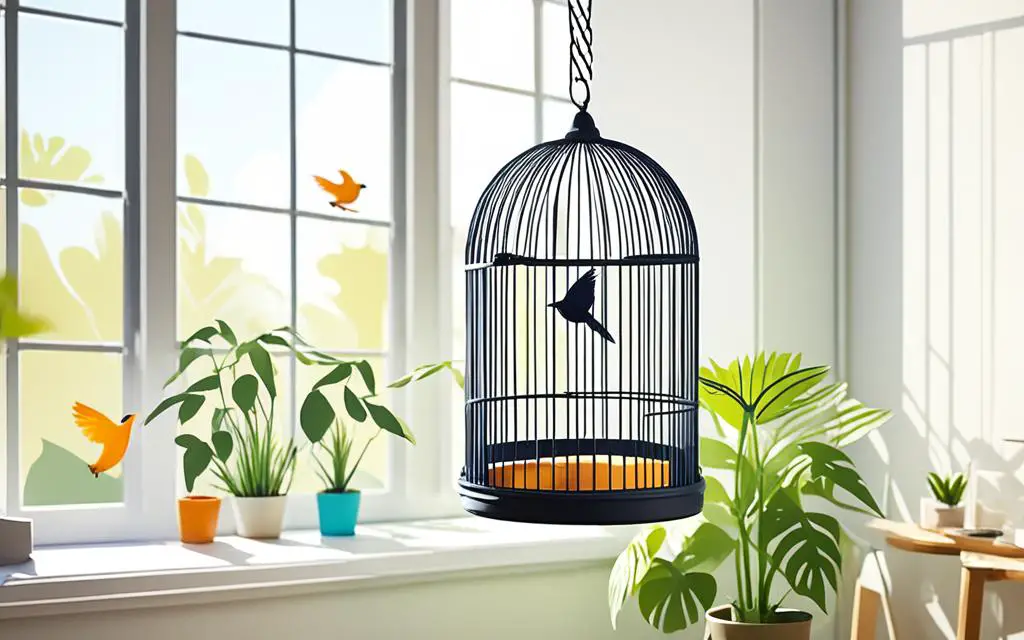
Bird Cage Placement for Foraging and Roaming
Emulating natural bird behaviors within the confines of a home also involves considering how your bird can forage and roam. For species that are naturally inclined to search for food, an environment that allows space for this activity promotes mental alertness and physical fitness.
Introduce a variety of feeding stations at different levels and locations within the cage to encourage movement and exploration. For those who can dedicate a specific area of the home, a full-flight aviary could satisfy these instincts further by allowing birds to roam more freely and partake in a more dynamic foraging experience.
Remember, your bird’s enclosure is their world. By creating a space for them that caters to their natural bird behaviors, including sufficient bird cage placement for foraging, you enhance their quality of life and promote a happier, more content pet.
Maintaining Pet Bird Enclosures: Hygiene Importance
As you welcome a pet bird into your home, maintaining a clean environment becomes essential, directly impacting their health and contentment. A strategic approach to cage maintenance and pet bird habitat hygiene involves implementing daily cleaning routines and considering ease of maintenance when positioning their enclosure.
Daily Cleaning Routines to Ensure a Sanitary Living Space
Dedication to daily cleaning routines is pivotal for the upkeep of your bird’s health. Daily tasks should include washing and disinfecting food and water bowls, changing cage liners, and wiping down surfaces. This routine sustains a sanitary living space, preventing the spread of disease and infection which can quickly take hold in an untidy pet bird habitat.
Here are some steps to incorporate into your bird’s daily hygiene routine:
- Remove uneaten food to prevent spoilage and bacterial growth.
- Clean water dishes to ensure fresh drinking water, free from contamination.
- Change out cage liners to keep the base of the cage clean and odor-free.
- Regularly inspect toys and perches for signs of wear and soiling, cleaning or replacing them as necessary.
Proper Placement to Minimize Cage Mess and Ease of Maintenance
The positioning of your bird’s cage can simplify your ease of maintenance tasks. Consider placing the cage on a dedicated protective floor pad, which is designed to catch any mess and simplifies the clean-up process. This strategic placement allows for easy accessibility during cleaning and decreases the time spent on maintenance duties. When choosing a location for your pet’s cage, contemplate the following:
- Ensure the cage is not over carpets or rugs, which harbor bacteria and are difficult to clean.
- Locate the cage in a place that is easy to reach for daily maintenance without disturbing your pet.
- Consider non-porous flooring or protective pads for swift cleanup of any splashes or debris.
Integrating these practices into your daily care routine will help ensure that your bird’s home remains a pristine and pleasant space. Remember, a clean habitat is just as much about your bird’s well-being as it is about daily convenience and pet bird habitat hygiene.
Integration of Pet Birds into Your Daily Life
Successfully blending pet bird daily integration into the family setting requires keen attention to both their physical environment and their social needs. Ensuring a seamless incorporation of your feathered friend into your living spaces not only enriches their life but also fosters a bond between you and your bird. A harmonious balance between safety and interaction can be achieved with intentional cage placement and structured bedtime routines that cater to your bird’s natural cycles.
Combining Safety with Social Interaction in Living Spaces
When considering cage placement, position your bird’s home in a communal area that is active yet safe. This could be a quiet corner of the living room or an enclosed porch where interactions with family members can occur without high volumes of fast-moving traffic or loud disturbances. It allows your bird to be part of your life’s daily rhythm, offering mental stimulation without overwhelming them.
Bedtime Routines: Day and Night Cage Placement for Proper Rest
To facilitate restful sleep and regular cycles of wakefulness for your bird, establish bedtime routines that replicate the natural setting of dusk and dawn. A separate, tranquil location for nighttime rest – such as a room with subdued lighting and away from the household’s evening activities – ensures your bird receives the downtime needed for their health and well-being. This day-to-night cage transition helps indicate to your pet bird that the day has ended and it’s time to rest.
By instilling these practices, you can create a living environment for your pet bird that promotes both safety and social interaction. Whether enjoying the daytime activities with the family or winding down in a quieter space for the night, your bird’s integration into your household will bring joy and companionship to your daily life.
- Locate the bird’s primary cage in a social yet secure part of your home.
- Provide a secondary, quiet cage to establish optimal sleep habits.
- Ensure that both day and night environments are safe from hazards and encourage natural behaviors.
Conclusion
As we wrap up our exploration of creating the ideal habitat for your pet bird, it’s vital to remember the key elements that contribute to a nurturing environment. The optimal bird cage position within your home hinges on a careful assessment of your bird’s natural inclinations for space, freedom, and comfort. Recognizing the nuances of bird safety, ensuring protection against common household hazards, and facilitating regular social interactions are imperative for their well-being.
Summarizing the Key Factors for Housing Pet Birds at Home
To recapitulate, positioning the bird cage in your home requires thoughtful consideration of several vital factors. It’s essential to provide ample space for movement and flight, establish a secure location free from predators and fumes, and be attentive to temperature and ventilation nuances that can impact bird comfort. Social interaction is a crucial aspect of their mental health—position your bird’s cage in an area that allows them to be a part of family life without overwhelming them with noise or activity. These considerations ensure that the environment aligns with their instinctual needs and promotes a satisfying life in captivity.
Final Tips on Optimizing Your Bird’s Living Environment
In conclusion, optimizing your bird’s living environment extends beyond mere aesthetics. It encompasses a holistic approach that considers pet bird habitat tips—integrating safe and stimulating enrichment opportunities, maintaining scrupulous hygiene, and adapting to the bird’s diurnal rhythms for rest and activity. Embrace these strategies to ensure your avian friend leads a happy, healthy life under your care. Your sensitivity to these details vividly illustrates your commitment to providing an enriching, safe haven for your cherished companion.
FAQ
What is the best place for a pet bird cage in my home?
How important is the size of the bird cage for my pet’s well-being?
Should my bird’s cage be positioned for social interaction?
Why is natural light important for my pet bird, and how do I manage it?
How should I control the temperature around my bird’s cage?
What toxins and household dangers should I keep my bird away from?
How does cage placement impact my pet bird’s mental health?
How do I ensure proper ventilation for my bird’s habitat?
What are the guidelines for setting up safe and secure bird enclosures?
What natural behaviors should a bird cage position encourage?
How do I maintain hygiene in my bird’s cage?
How does cage placement affect a bird’s day and night routines?
How can I optimize my bird’s living environment at home?
Source Links
- https://kb.rspca.org.au/knowledge-base/how-should-i-house-my-bird/
- https://kb.rspca.org.au/knowledge-base/where-should-i-keep-my-birds/
- https://www.fearfreehappyhomes.com/setup-bird-cage/

My name is Shane Warren, the author behind Your Bird Buddy – your ultimate guide to the wonderful world of birds! Unleash your inner avian explorer as we delve into a vibrant library of knowledge dedicated to all things feathered. From learning about diverse bird species from across the globe to understanding their captivating habitats and behaviors, I’m here to fuel your passion for these magnificent creatures. Not only that, but I also provide valuable insights on being a responsible and informed pet bird owner. Join our vibrant community and let’s celebrate the feathered wonders of the world together – one chirp at a time. And be sure to join our Your Bird Buddy Community over on Facebook!

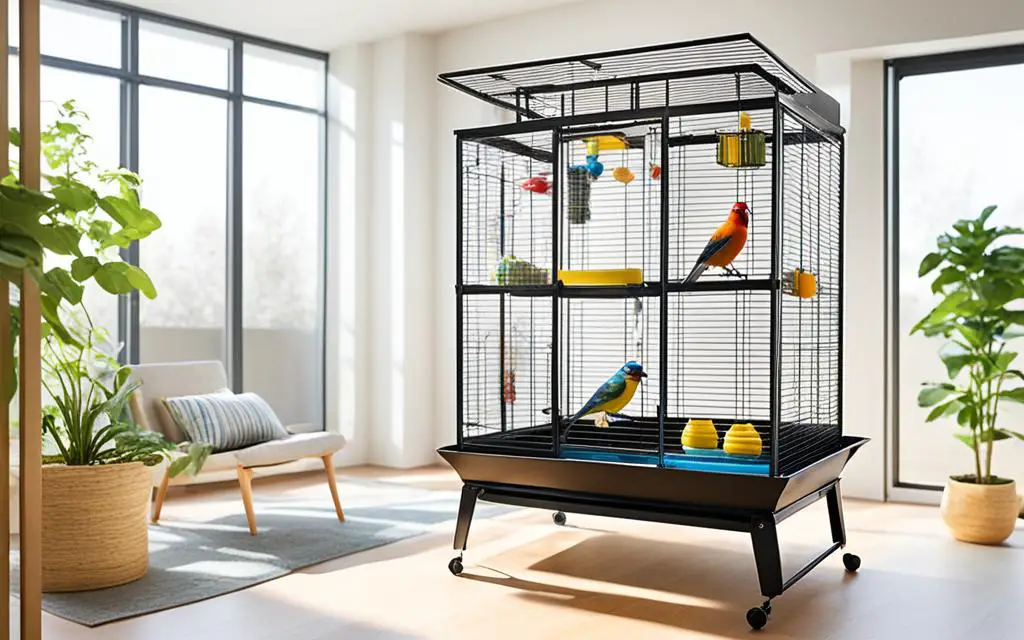
Comments are closed